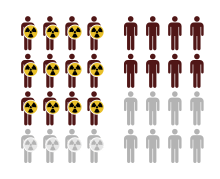Attributable fraction among the exposed
In epidemiology, attributable fraction among the exposed (AFe) is the proportion of incidents in the exposed group that are attributable to the risk factor. Term attributable risk percent among exposed is used if the fraction is expressed as a percentage.[1] It is calculated as , where is the incidence in the exposed group, is the incidence in the unexposed group, and is the relative risk.[2]

It is used when an exposure increases the risk, as opposed to reducing it, in which case its symmetrical notion is preventable fraction among the unexposed.
Synonyms
Multiple synonyms of AFe are in use: attributable fraction,[1][3] relative attributable risk,[1] attributable proportion among the exposed,[1] attributable risk among the exposed.[4]
Similarly, attributable risk percent (ARP) is used as a synonym for the attributable risk percent among the exposed.[3]
In climatology, fraction of attributable risk (FAR) is used to denote a proportion of adverse event risk attributable to the human influence on climate or other forcing factor.[5]
Numerical example
| Example of risk increase | |||
|---|---|---|---|
| Experimental group (E) | Control group (C) | Total | |
| Events (E) | EE = 75 | CE = 100 | 175 |
| Non-events (N) | EN = 75 | CN = 150 | 225 |
| Total subjects (S) | ES = EE + EN = 150 | CS = CE + CN = 250 | 400 |
| Event rate (ER) | EER = EE / ES = 0.5, or 50% | CER = CE / CS = 0.4, or 40% | |
| Equation | Variable | Abbr. | Value |
|---|---|---|---|
| EER − CER | absolute risk increase | ARI | 0.1, or 10% |
| (EER − CER) / CER | relative risk increase | RRI | 0.25, or 25% |
| 1 / (EER − CER) | number needed to harm | NNH | 10 |
| EER / CER | risk ratio | RR | 1.25 |
| (EE / EN) / (CE / CN) | odds ratio | OR | 1.5 |
| (EER − CER) / EER | attributable fraction among the exposed | AFe | 0.2 |
See also
- Population Impact Measures
- Attributable fraction for the population
References
- "Dictionary of Epidemiology - Oxford Reference". Oxford University Press. 2014. doi:10.1093/acref/9780199976720.001.0001. ISBN 9780199976720. Retrieved 2018-05-09.
- Cole P, MacMahon B (November 1971). "Attributable risk percent in case-control studies". Br J Prev Soc Med. 25 (4): 242–4. doi:10.1136/jech.25.4.242. PMC 478665. PMID 5160433.
- J., Rothman, Kenneth (2012). Epidemiology : an introduction (2nd ed.). New York, NY: Oxford University Press. p. 66. ISBN 9780199754557. OCLC 750986180.
- P., Armitage (2002). Statistical methods in medical research. Berry, G. (Geoffrey), Matthews, J. N. S. (4th ed.). Oxford: Blackwell Scientific Publications. p. 683. ISBN 9780470773666. OCLC 646751070.
- Peter A. Stott; et al. (2013). "Attribution of Weather and Climate-Related Events". In Asrar, Ghassem; Hurrell, James W. (eds.). Climate science for serving society : research, modeling and prediction priorities. Dordrecht: Springer. p. 315. ISBN 9789400766921. OCLC 851370783.